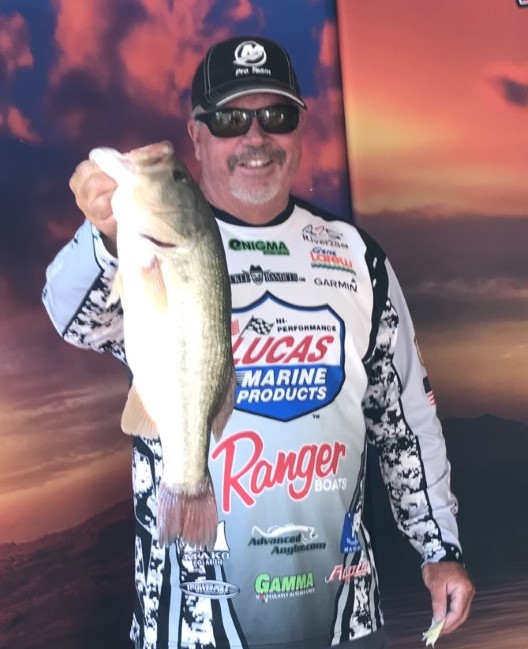Are you thinking about heading south to fish this winter? Many of you do, and Florida is the destination for many snowbirds.
The Sunshine State offers some of the best fishing in the world, and it’s a great place to fish almost 365 days a year. The only wrench that seems to mess up Florida’s fish factories is a good old fashioned cold front. Florida-strain largemouth grow big and beautiful, but they are temperamental when the dial turns to chillier temperatures.
How Two Pro Anglers Tackle Florida Fishing in Chilly Weather

Professional anglers Bradley Roy (Bass Pro Tour) and Brandon Lester (Bassmaster Elite Series) have seen this all too many times, whether in competition or the practice days leading up to an event. They have often battled the decisions of staying in an area or leaving for Plan B because the fish have moved.
For Lester and Roy battling those conditions and making the correct decision on gameday starts well before a cold front hits. Like many high-level pros, they map out their options to make calculated decisions on the water to limit the amount of wasted time while adjusting to a temperature change. A lot of planning begins in practice.
“I like to find areas with a variety of cover instead of just finding a specific spot,” Lester said. “If I can find a mixture of vegetation and cover, then finding where the fish move within the area is a lot easier.”
Every Spawning Bass is Different

Most pro-level Florida events happen early in the year where fish are spawning or thinking about doing so, and a sudden change in temperature for the lesser can halt that process quickly. Every spawning bass is different, and some will stay dedicated to a bed during harsh weather changes, while others haven’t quite reached that point so they can easy to safe cover and wait it out while a male bass can stay and protect the nesting area.
To catch those bigger females that pull off during a cold spout, Roy turns his eyes to cover that is thicker and nastier than the rest of the given area.
“I’ll scout out big matted grass patches, thick reed clusters, and another heavy cover that is nearby for this specific instance,” Roy said. “When the temperatures turn for the worst in Florida, it can’t hurt to pull the big stick out and probe the heaviest cover in the area.”

To punch through the heavy cover with a 1 to 2-ounce tungsten weight, Roy opts for a 7-foot 9-inch extra-heavy flipping stick, and 65-pound Seaguar Smackdown fishing line in stealth gray, to make sure he has the backbone to pull those big fish out of the thick stuff.
“Often, those fish don’t move to the mats looking to eat or chase bait,” Roy says. “They are hiding from a north wind or hunkering down to the vegetation that will hold the most heat. Picking apart the mat is important because most bites will come when you drop it on their head. They can be lethargic, so giving a couple of bounces and pitching back down there can be key.”
Dealing With Little Cover on Some Florida Lakes

Roy has a remedy for those Florida lakes that may not have many mats or thick patches of cover. For Florida’s Lake George, he believes finding thicker and more concentrated patches of eelgrass or hydrilla off-shore can be just as effective. Instead of punching the thick cover, he likes to bring a lipless crankbait like the Bass Pro Shops XPS Rattle Shad or the popular Strike King Red Eye Shad through the submerged vegetation, giving it pops and ripping it through the grass after it ticks the top.
Lester echoed Roy’s sentiment about the heavy cover approach, and he believes one issue anglers have with cold-front conditions in Florida is how fast they fish.
“Florida fish aren’t the easiest to catch while moving fast, but especially under cold front conditions,” Lester said. “If I pull up to a good-looking mat, then I would normally try and make a flip every 2 to 5 feet because you’re going to have to convince them to bite, even though they don’t necessarily want to.”
How to Fish the Thick Florida Cover

Lester’s arsenal for approaching the thickest Florida cover is simple, but focusing is very vital. He likes to use a heavy-action flipping stick with a 1 ½-ounce tungsten weight, which is his ideal weight overall for targeting those thick pieces of cover. He loves an X Zone Lures Muscle Back Finesse Craw rigged on a 3/0 or 4/0 Mustad 3X Grip Pin Max flipping hook, which helps him keep his compact creature bait on the shank of the hook while penetrating the abrasive cover. To round out his setup, he pairs 65-pound Vicious No Fade Braid to a high-speed reel to ensure he can pick up enough slack to muscle those trophy fish from under the matted cover.
Be prepared for weather cold fronts; they can be one of the trickiest things to figure out in Florida. Just think about the heavy cover and lethargic bass when timing your pitches and flips into the jungle of vegetation. And if the fish don’t cooperate the whole time, just remember how even during a cold front the weather is still probably way better than it is back home!




